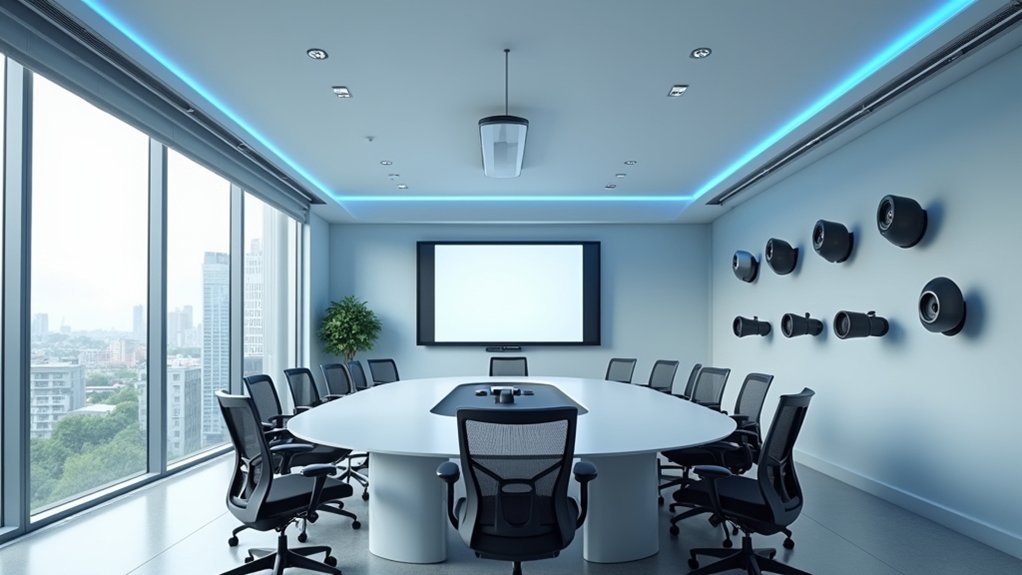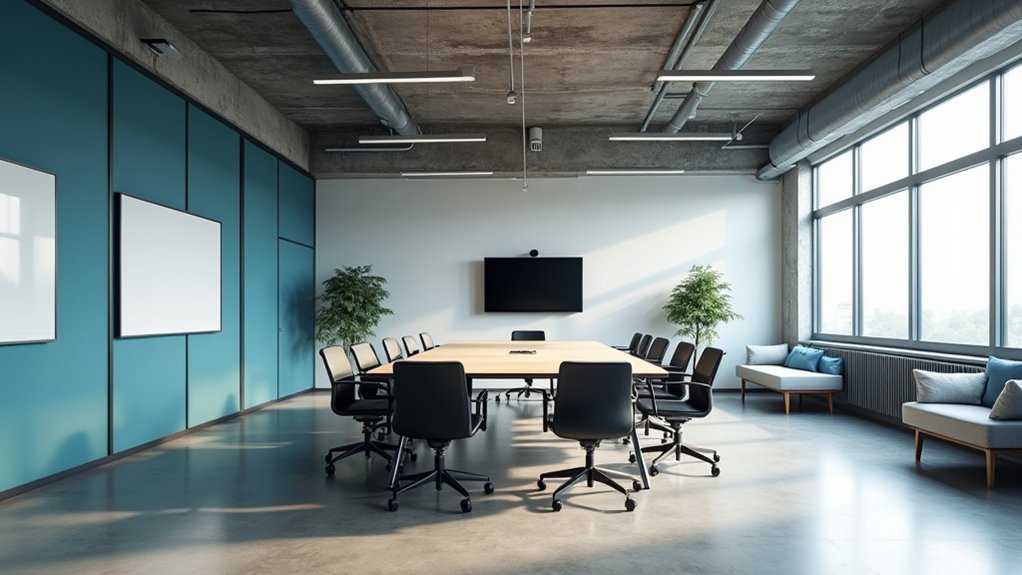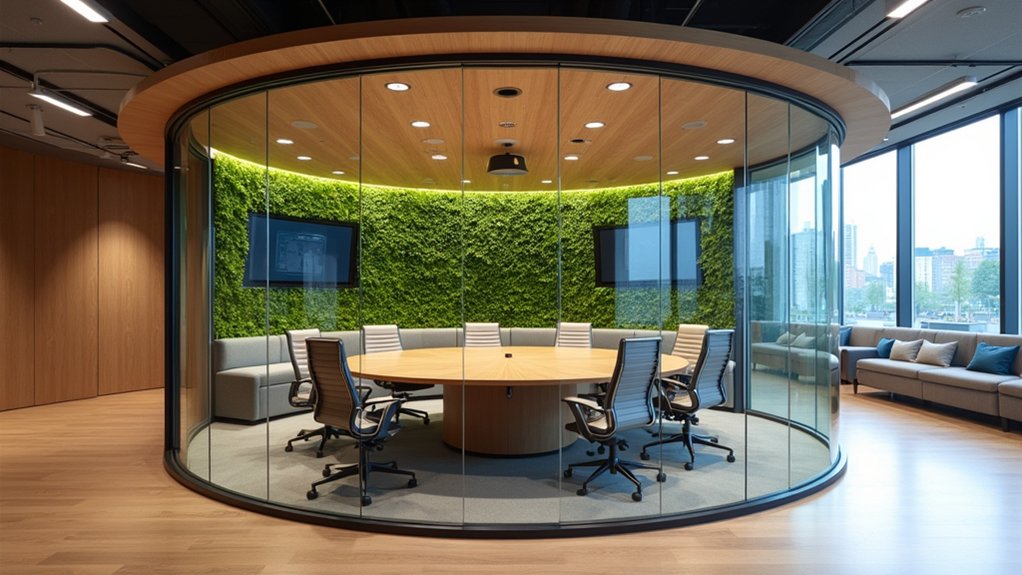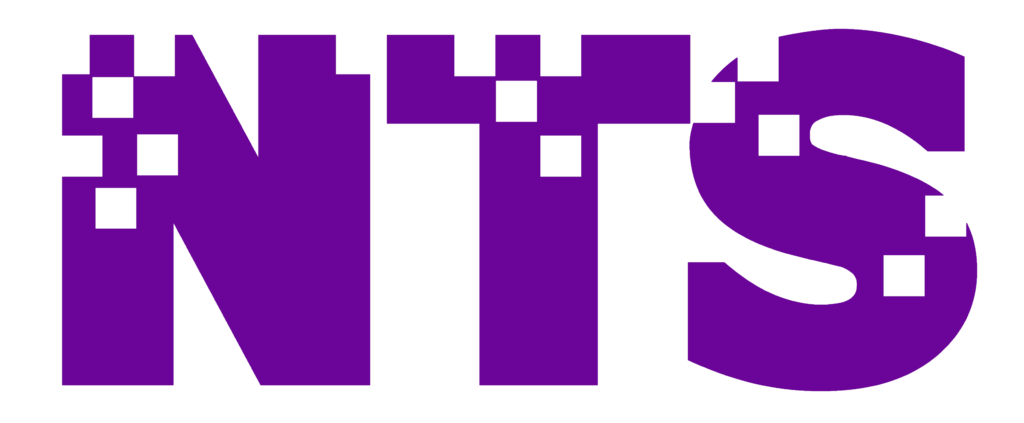Hybrid meeting rooms need careful planning to work well for both in-person and online meetings. The basics include flexible work spaces with good video and sound equipment, movable furniture, and easy-to-use room booking tools. Putting microphones, speakers, and lights in the right spots helps everyone join in smoothly, whether they’re in the room or joining remotely. Good sound control and touches of nature help people feel better and work better. These core ideas help create useful spaces that can change as work needs change.
Key Takeaways
- Create adaptable meeting spaces with movable furniture and integrated technology to support both in-person and remote collaboration effectively.
- Install high-quality audio-visual equipment including smart cameras, microphones, and speakers to ensure clear communication for all participants.
- Implement user-friendly room booking systems and control panels to help employees easily manage and access meeting spaces.
- Design spaces with proper acoustics, lighting, and sound control to enhance meeting quality and reduce distractions.
- Incorporate flexible layouts that accommodate different meeting styles while maintaining employee wellbeing through natural elements and ergonomic features.
Understanding the Core Elements of Effective Hybrid Spaces

Physical offices used to be built just for face-to-face work, but today’s hybrid spaces need to work well for both in-person and online teamwork.
To make hybrid spaces work, you need several key parts: work areas that can change based on different tasks, team spaces with good tech tools placed in the right spots, and ways to keep noise down so people can focus. The space should be easy for everyone to use and support worker health.
Simple room booking tools help people find and use spaces when needed, while tracking how spaces are used helps make them better over time.
When these pieces come together, the workplace truly helps people do their best work, whether they’re in the office or connecting from somewhere else.
Virtual event platforms are becoming essential components of hybrid workspaces, enabling seamless collaboration between in-person and remote team members without travel constraints.
Technology Integration Strategies for Seamless Collaboration
Making Hybrid Meetings Work Better for Everyone
How can companies make sure their meeting rooms work well for both in-person and online participants? The key is using the right technology in smart ways that help people work together easily.
Companies should buy good video meeting systems and use common platforms like Pexip so different tools can work together smoothly. Putting microphones and speakers in the right places helps everyone hear each other clearly. Good lighting makes it easier to see and reduces tired eyes, especially for people joining from home.
As workplaces mix online and in-person work, they need furniture that can move and change, along with portable technology that fits different types of meetings. This complete setup creates meeting spaces where technology helps people work together instead of getting in the way. Using acoustic panels and baffles helps reduce echo and improve sound quality for more effective communication during hybrid meetings.
Creating Flexible Environments That Support Multiple Work Styles

The best hybrid workspaces can change and grow to match how different people like to work. Today’s offices need spaces where people can work quietly alone and areas where teams can work together, whether they’re in the office or joining remotely.
Good office design uses furniture that moves and changes, easy-to-use room booking tools that show which spaces are free, and areas that can be quickly set up for different tasks. Teams work best when the office handles noise well and offers both quiet spots for focused work and open areas for group projects.
Success comes from building a workplace where everyone can do their best work in ways that suit them best. This flexible approach to workspace design enables companies to achieve enhanced operational efficiency while maintaining focus on core business activities.
Optimizing Audio-Visual Solutions for Remote Participation
Getting hybrid meetings right means using good sound and video tools so people joining from home feel just as much part of the team. Clear microphones and speakers, along with smart sound setups, help make the room sound natural for everyone, whether they’re in the office or joining remotely.
Cameras that follow whoever is talking help remote workers see what’s happening without missing anything. Tools that cut out unwanted noise keep the focus on the conversation, while easy-to-use control systems make it simple to book rooms and run the equipment.
When all these tools work together, they help create meetings where everyone can join in and work together easily, no matter where they are. Interactive display solutions allow participants to collaborate seamlessly by drawing and annotating content in real-time during presentations.
Designing for Employee Wellbeing and Productivity

Simple workspace design goes beyond just adding technology – it needs careful planning to help employees feel good and work well. Using natural light and adding plants and natural materials helps people feel connected to the outdoors while helping them think better and be more creative. Interactive display systems create engaging environments that enhance both in-person and remote collaboration.
| Design Element | How It Helps People |
|---|---|
| Natural light | Better mood and focus |
| Nature-based features | Less stress |
| Sound control | Better focus |
| Flexible spaces | Happier workers |
Companies can make their workspaces work better by creating both team areas and quiet spots for different types of work and worker needs. Adding sound-blocking panels and noise control in the right places helps people focus while still allowing for team activities and online meetings.
Measuring and Adapting Hybrid Spaces for Long-Term Success
The best hybrid workplaces need regular checks and updates to stay useful over time. Companies must watch closely how their spaces work and listen to what employees say – both those in the office and those working from home.
To track success, companies should look at:
- Numbers showing how people use meeting rooms and work together
- How well and how happily employees work
- When and how different teams use office space
- What workers say about their comfort and happiness at work
Using this information, companies can make smart changes to their office setup and tools. By staying flexible and making updates when needed, hybrid spaces can keep working well for everyone as work habits change.
Frequently Asked Questions
How to Make Hybrid Meetings Work?
Remote and in-person meetings work best when teams focus on clear video feeds, cut down on background noise, use online tools like shared drawing boards, and make sure everyone – both in the room and at home – can join in and feel like part of the team.
How to Design a Hybrid Office?
Clean office design mixes well-spaced desks, shared tables, and different work areas. Smart desk layouts, good lighting, video call equipment, and quiet meeting rooms help teams work together smoothly, whether they’re in the office or working remotely.
What Is a Hybrid Meeting Space?
A hybrid meeting space mixes regular seating, group work areas, and movable video chat tools with good sound control and easy-to-use tech. This setup helps both people in the room and those joining from far away work together and talk clearly with each other.
What Is the Best Technology for Hybrid Meetings?
The best tools for hybrid meetings bring together key elements: video meeting gear, online teamwork platforms, digital drawing boards, touch-enabled screens, wireless content sharing, smart digital helpers, and live speech-to-text features. When combined, these tools help everyone join in and work together smoothly, whether they’re in the room or joining from somewhere else.
Conclusion
Successful hybrid meeting spaces require thoughtful design, seamless technology integration, and continuous adaptation to user needs. Organizations that partner with Nye Technical Services can create flexible environments, implement high-quality audio-visual solutions, and support employee wellbeing to position themselves for long-term success in the evolving workplace. By measuring space utilization and gathering user feedback, businesses can refine their hybrid environments to maximize collaboration, productivity, and team satisfaction across all work modes.




